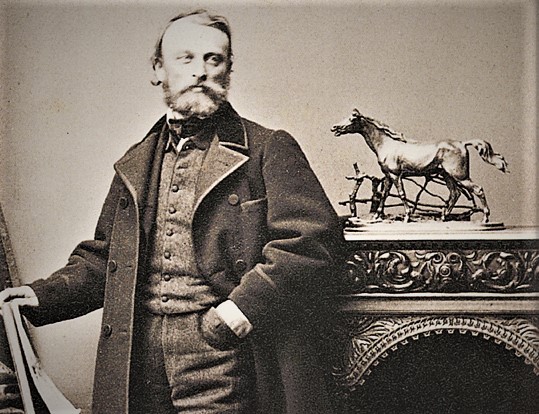

Pierre- Jules Mène (1810 - 1879)
Son of a copper turner, Pierre-Jules Mène was born in 1810. He quickly helped his father in the workshop, and therefore he was introduced to metalwork at a very young age.
Pierre-Jules Mène began drawing at a very early age, and in particular, had a predilection for the great horse painter Horace Vernet (1789-1863). In 1832, he got married and left his father's business to make a living from his sculpture. In order to provide for his needs, Mène created small models for porcelain manufacturers, which were very successful.
Mène continued his artistic training with the sculptor René Compaire. At the menagerie of the Jardin des Plantes, at the slaughterhouses of Montmartre and at the horse markets, he studied the anatomy of animals, every detail, every muscle.
Mène took part in many salons from 1838 to 1879: the animalier fashion started by Barye and Fratin created a receptive public and his commercial success was immense. As a regular exhibitor at the Salon des Beaux-Arts many of Mêne’s subjects were shown to the public in this popular showcase. This also served to establish public awareness of his new works and provides a useful reference when dating the origin of a particular cast. As a further point of reference, Mêne produced a catalogue of all his works and each of his models has an identifiable catalogue number. The sculptor was awarded a first-class medal at the salons of 1852 and 1861.
Beginning in 1838 Mène worked at his own foundry, casting first his own works and later also those of his son-in-law Auguste Cain. He became absorbed in the meticulous work of casting and chiselling and ensured that during his lifetime the bronzes that were cast were always checked for quality, colour and finish before they were allowed to leave the foundry.
The quality of his casts was recognized, and he proved, along with Barye, to be the most consistently successful over the longest period of time. While Barye could be described as the master of wild jungle animals, Mène is the greatest sculptor of horses, dogs and game. Pierre-Jules Mène is today still one of the best-known artists of the French Animalier School and his bronzes are among the most popular in this genre. Collectors of his work find relaxation and enjoyment in contemplating the innate grace and beauty of his sculptures.
After Mène’s death in 1879 the Barbedienne and Susse Frères foundries acquired the rights to reproduce many of his important models and these posthumous casts are marked F. Barbedienne Fondeur and Susse Frères fondeur editeur respectively. These bronzes are of fine quality and are cast by the leading bronze foundries in the late 19th and early 20th Centuries, however, they do not have the vitality and attention to detail that Mène achieved on the casts from his own foundry.